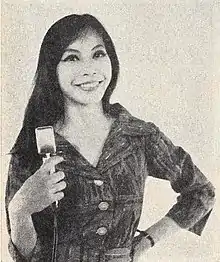Jacqui Chan
Jacqueline "Jacqui" Chan (born 1939) is a Chinese-Trinidadian dancer, actress and singer.[1][2]
Jacqui Chan | |
|---|---|
 Jacqui Chan in March 1961. | |
| Born | Jacqueline Chan 1939 (age 83–84) |
| Occupation(s) | Actress, dancer, singer |
Early life
Chan was born in Port of Spain, Trinidad and Tobago to a Chinese mother and a Chinese-Russian father. Her parents had both migrated to British Guiana as indentured laborers to work on a sugar cane plantation after the abolition of slavery.[1] She moved to London at age 16, and studied ballet at the Elmhurst Ballet School. She enrolled on a four-year teaching course at the Royal Academy of Dancing, but quit after a year and joined the cast of Teahouse of the August Moon. [3]
Acting career
Chan became a principal dancer in the London West End production of The King and I, and was soon placed in the London stage production of The World of Suzie Wong. In the immensely successful film version of the play, she played, against type, the rather plain Gwennie earning appreciative notice. Subsequently she performed the leading role in the 1961 stage production in Australia. Other acting roles included parts in Dixon of Dock Green, Armchair Theatre, Ghost Squad, The Saint, The Main Chance and Marco Polo.[4] Chan also appeared in the movies Cleopatra and Krakatoa: East of Java.[5]
Chan also performed a spoken interlude in Mandarin Chinese on the recording of the 1967 psychedelic song Kites by the British band Simon Dupree and the Big Sound, which reached number 9 on music charts in the United Kingdom in late 1967. According to the later testimony of the group's then-bassist, Peter O'Flaherty, he didn't know the meaning of the Chinese words that Chan was saying, and neither did she.[6]
Popular culture
In the Netflix series The Crown, Chan is played by Chinese-born British actress Alice Hewkin.[7] In the series, Chan is depicted having a brief sexual relationship with Antony Armstrong-Jones before his marriage to Princess Margaret.[4] Her portrayal in the series has led to criticism, with some alleging her appearance played into orientalist stereotypes.[8]
References
- Clarke, Hilary (10 October 2018). "Jacqui Chan on that sex scene from The Crown, being a Chinese actress in the 1960s and why she's still in demand". South China Morning Post.
- "Jacqui Chan, Actress and singer". National Portrait Gallery.
- "JACQUI (not Jackie) CHAN —don't ask her about Tony". Australian Women's Weekly. 1961-02-01. Retrieved 2021-11-18.
- Hallemann, Caroline (2017-12-18). "Who Was Antony Armstrong-Jones's Former Girlfriend, Jacqui Chan?". Town & Country. Retrieved 2021-11-18.
- The Crown Who Was Jacqui Chan?
- "In the 1967 hit 'Kites' by Simon Dupree and the Big Sound, a girl speaks in an apparent Chinese dialect. Does anyone know what it means?" Notes and Queries. guardian.co.uk.
- The Crown Characters with Their Real-Life Counterparts
- Princess Margaret Actress Vanessa Kirby Defends Graphic Sex Scene